 previous article in this issue previous article in this issue | next article in this issue  |

|
Document Details : Title: Barmherzigkeit als Betroffenheit von der Not des Anderen und als Einsatz für soziale Gerechtigkeit Subtitle: Eine Nachlese zum Jahr der Barmherzigkeit Author(s): LINTNER, Martin M. Journal: ET-Studies Volume: 9 Issue: 2 Date: 2018 Pages: 251-271 DOI: 10.2143/ETS.9.2.3285138 Abstract : 'Ein wenig Barmherzigkeit macht die Welt weniger kalt und viel gerechter. Wir haben es notwendig, diese Barmherzigkeit Gottes gut zu verstehen, dieses barmherzigen Vaters, der so viel Geduld hat.' Diese Aussage von Papst Franziskus bei seinem ersten Angelusgebet am 17. März 2013 kann als Leitmotiv seines Pontifikats verstanden werden. In der Ankündigungsbulle des außerordentlichen Jubiläums der Barmherzigkeit 2016 nennt der Papst die Barmherzigkeit 'das pulsierende Herz des Evangeliums', 'den Tragbalken, der das Leben der Kirche stützt'. Will diese Rede keine bloße Rhetorik bleiben, muss Barmherzigkeit konkret werden. In vielen Gesten bringt sie der Papst zum Ausdruck. Nach ihm kommt eine Kirche, die glaubhafte Zeugin der Barmherzigkeit sein will, zudem nicht umhin, sich entschieden für die Überwindung jener Faktoren einzusetzen, die Armut und Not bewirken. Barmherzigkeit auf individualethischer und Gerechtigkeit auf sozialethischer Ebene bedingen einander. Der Einsatz für Gerechtigkeit kann als sozialethische Kehrseite der Barmherzigkeit verstanden werden und, umgekehrt, die Barmherzigkeit als Motor für die Suche nach bzw. die Verwirklichung von Gerechtigkeit. Der vorliegende Beitrag versteht sich als Nachlese zum 'Jahr der Barmherzigkeit', mit dem Papst Franziskus diese theologisch oft vernachlässigte Tugend nicht nur in Erinnerung gerufen, sondern der Kirche als wesentlichen Aspekt ihres Selbstverständnisses und ihres Wirkens neu ins Stammbuch geschrieben hat. Anhand der konkreten Handlungen und Äußerungen des Papstes soll ein mögliches Verständnis von Barmherzigkeit herausgearbeitet werden. Aufgrund dieser Zielsetzung bleiben Theorieprobleme oder Konflikte in den theologischen Diskursen über die Barmherzigkeit weitgehend ausgeblendet. 'A little mercy makes the world less cold and much fairer. We must understand this mercy of God properly, this merciful Father, who shows so much patience.' This statement of Pope Francis in his first Angelus prayer of 17 March 2013 can be understood as a leitmotif of his pontificate. In the Bull published at the beginning of the Jubilee Year of Mercy in 2016, the Pope called mercy 'the pulsing heart of the gospel', 'the beam that supports the life of the church'. If this speech is not to remain mere rhetoric, mercy must become concrete. The pope brings it to expression through many gestures. According to him, a church that will be a credible witness to mercy cannot help itself decisively overcoming those factors that have caused poverty and hardship. Mercy in individual ethics and justice in social ethics are interdependent. The employment of justice can be understood as the downside of the social ethics of mercy and, by contrast, mercy can be understood as the driving force of the search for the realisation of justice. The following article understands itself as a reflection on the Year of Mercy, in which Pope Francis remembered mercy not only as an often neglected theological virtue, but he described it in the handbook as an essential aspect of the self-understanding of the church and its activity. On the basis of specific acts and statements of the pope, a possible understanding of mercy will be worked out. Because of this objective, theoretical problems and conflicts in theological discourses on mercy will remain unexplored. «Un peu de miséricorde rend le monde moins froid et plus juste. Nous avons besoin de bien comprendre cette miséricorde de Dieu, ce Père miséricordieux qui a une telle patience.» Cette déclaration du pape François dans sa première prière de l’Angélus, le 17 mars 2013, peut s’entendre comme un leitmotiv de son pontificat. Dans la bulle publiée au début de l’année jubilaire de la Miséricorde, en 2016, le pape a qualifié la miséricorde de «cœur battant de l’Évangile», de «pilier qui soutient la vie de l’Église». Si ce discours ne doit pas rester pure rhétorique, la miséricorde doit devenir concrète. Le pape le fait comprendre à travers de nombreux gestes. Selon lui, une Église ne pourra pas être un témoin crédible de la miséricorde si elle ne surmonte pas de manière décisive les facteurs de pauvreté et de misère. Miséricorde, dans l’éthique individuelle, et justice, dans l’éthique sociale, sont interdépendantes. Le recours à la justice peut être compris comme l’inconvénient de l’éthique sociale de miséricorde, et, par contre, la miséricorde peut être comprise comme la force motrice de la recherche pour réaliser la justice. Cet article se veut une réflexion sur l’année de la Miséricorde, dans laquelle le pape François n’a pas seulement évoqué la miséricorde comme une vertu théologale souvent négligée mais l’a décrite dans le livret comme un aspect essentiel de la compréhension que l’Église a d’elle-même et de son activité. Sur la base d’actes et de déclarations spécifiques du pape, il élabore une compréhension possible de la miséricorde. Du fait de cet objectif, il n’abordera pas les problèmes théoriques et les conflits dans les discours théologiques sur la miséricorde. |
 |
